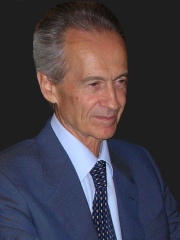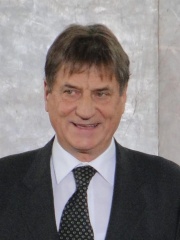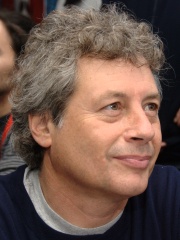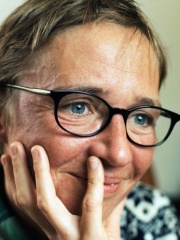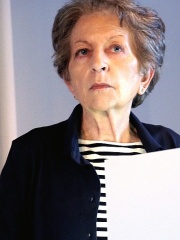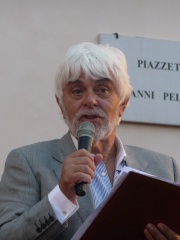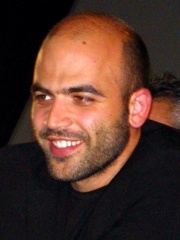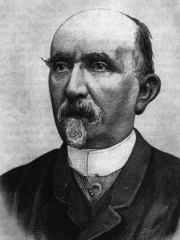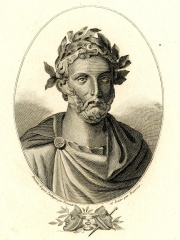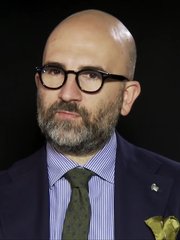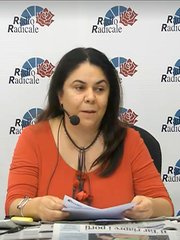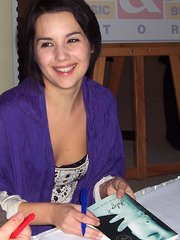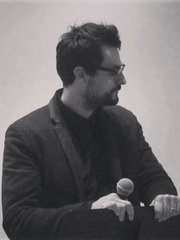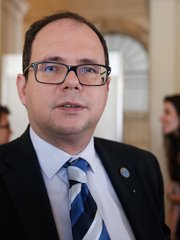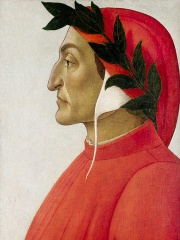
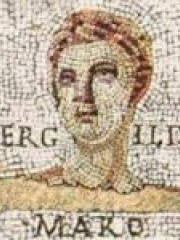
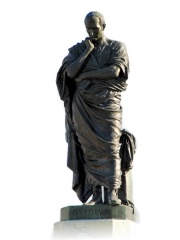
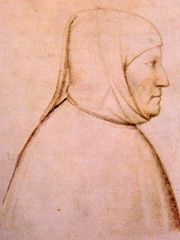
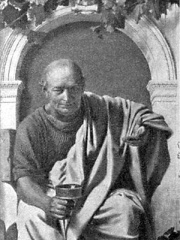
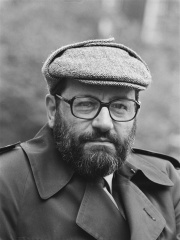
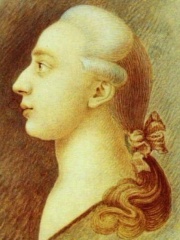
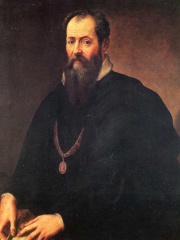
The Most Famous
WRITERS from Italy
Top 10
The following people are considered by Pantheon to be the top 10 most legendary Italian Writers of all time. This list of famous Italian Writers is sorted by HPI (Historical Popularity Index), a metric that aggregates information on a biography's online popularity. Visit the rankings page to view the entire list of Italian Writers.

1. Dante Alighieri (1265 - 1321)
With an HPI of 92.13, Dante Alighieri is the most famous Italian Writer. His biography has been translated into 192 different languages on wikipedia.
Dante Alighieri (Italian: [ˈdante aliˈɡjɛːri]; most likely baptized Durante di Alighiero degli Alighieri; c. May 1265 – September 14, 1321), widely known mononymously as Dante, was an Italian poet, writer, and philosopher. His Divine Comedy, originally called Comedìa (modern Italian: Commedia) and later christened Divina by Giovanni Boccaccio, is widely considered one of the most important poems of the Middle Ages and the greatest literary work in the Italian language. At a time when Latin was still the dominant language for scholarly and literary writing—and when many Italian poets drew inspiration from French or Provençal traditions—Dante broke with both by writing in the vernacular, specifically his native Tuscan dialect. His De vulgari eloquentia (On Eloquence in the Vernacular) was one of the first scholarly defenses of the vernacular. His use of the Florentine dialect for works such as The New Life (1295) and Divine Comedy helped establish the modern-day standardized Italian language. His work set a precedent that important Italian writers such as Petrarch and Boccaccio would later follow. Dante was instrumental in establishing the literature of Italy, and is considered to be among the country's national poets and the Western world's greatest literary icons. His depictions of Hell, Purgatory, and Heaven provided inspiration for the larger body of Western art and literature. He influenced English writers such as Geoffrey Chaucer, John Milton, and Alfred Tennyson, among many others. In addition, the first use of the interlocking three-line rhyme scheme, or the terza rima, is attributed to him. He is described as the "father" of the Italian language, and in Italy he is often referred to as il Sommo Poeta ("the Supreme Poet"). Dante, Petrarch, and Boccaccio are also called the tre corone ("three crowns") of Italian literature.

2. Virgil (70 BC - 19 BC)
With an HPI of 88.05, Virgil is the 2nd most famous Italian Writer. His biography has been translated into 172 different languages.
Publius Vergilius Maro (Classical Latin: [ˈpuːbliʊs wɛrˈɡɪliʊs ˈmaroː]; 15 October 70 BC – 21 September 19 BC), usually called Virgil or Vergil ( VUR-jil) in English, was an ancient Roman poet of the Augustan period. He composed three of the most famous poems in Latin literature: the Eclogues (or Bucolics), the Georgics, and the epic Aeneid. Some minor poems, collected in the Appendix Vergiliana, were attributed to him in ancient times, but modern scholars regard these as spurious, with the possible exception of some short pieces. Already acclaimed in his lifetime as a classic author, Virgil rapidly replaced Ennius and other earlier authors as a standard school text, and stood as the most popular Latin poet through late antiquity, the Middle Ages, and early modernity, exerting major influence on Western literature. Geoffrey Chaucer assigned Virgil a uniquely prominent position in history in The House of Fame (1374–85), describing him as standing on a pilere / that was of tinned yren clere ("on a pillar that was of bright tin-plated iron"), and in the Divine Comedy, in which Virgil appears as the author's guide through Hell and Purgatory, Dante pays tribute to Virgil with the words tu se' solo colui da cu'io tolsi / lo bello stile che m'ha fatto onore (Inf. I.86–7) ("thou art alone the one from whom I took the beautiful style that has done honour to me"). In the 20th Century, T. S. Eliot famously began a lecture on the subject "What Is a Classic?" by asserting as self-evidently true that "whatever the definition we arrive at, it cannot be one which excludes Virgil – we may say confidently that it must be one which will expressly reckon with him."

3. Ovid (43 BC - 17)
With an HPI of 86.87, Ovid is the 3rd most famous Italian Writer. His biography has been translated into 134 different languages.
Publius Ovidius Naso (Latin: [ˈpuːbliʊs ɔˈwɪdiʊs ˈnaːsoː]; 20 March 43 BC – AD 17/18), known in English as Ovid ( OV-id), was a Roman poet who lived during the reign of Augustus. He was a younger contemporary of Virgil and Horace, with whom he is often ranked as one of the three canonical poets of Latin literature. The Imperial scholar Quintilian considered him the last of the Latin love elegists. Although Ovid enjoyed enormous popularity during his lifetime, the emperor Augustus exiled him to Tomis, the capital of the newly organised province of Moesia, on the Black Sea, where he remained for the last nine or ten years of his life. Ovid himself attributed his banishment to a carmen et error ("poem and a mistake"), but his reluctance to disclose specifics has resulted in much speculation among scholars. Ovid is most famous for the Metamorphoses, a continuous mythological narrative in fifteen books written in dactylic hexameters. He is also known for works in elegiac couplets such as Ars Amatoria ("The Art of Love") and Fasti. His poetry was much imitated during Late Antiquity and the Middle Ages, and greatly influenced Western art and literature. The Metamorphoses remains one of the most important sources of classical mythology today.

4. Petrarch (1304 - 1374)
With an HPI of 86.60, Petrarch is the 4th most famous Italian Writer. His biography has been translated into 109 different languages.
Francis Petrarch (; 20 July 1304 – 19 July 1374; Latin: Franciscus Petrarcha; modern Italian: Francesco Petrarca [franˈtʃesko peˈtrarka]), born Francesco di Petracco, was a scholar from Arezzo and poet of the early Italian Renaissance, as well as one of the earliest humanists. Petrarch's rediscovery of Cicero's letters is often credited with initiating the 14th-century Italian Renaissance and the founding of Renaissance humanism. In the 16th century, Pietro Bembo created the model for the modern Italian language based on Petrarch's works, as well as those of Giovanni Boccaccio, and, to a lesser extent, Dante Alighieri. Petrarch was later endorsed as a model for Italian style by the Accademia della Crusca. Petrarch's sonnets were admired and imitated throughout Europe during the Renaissance and became a model for lyrical poetry. He is also known for being the first to develop the concept of the "Dark Ages".
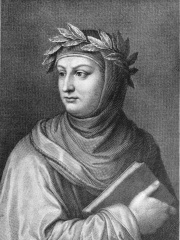
5. Giovanni Boccaccio (1313 - 1375)
With an HPI of 85.98, Giovanni Boccaccio is the 5th most famous Italian Writer. His biography has been translated into 110 different languages.
Giovanni Boccaccio (UK: bə-KATCH-ee-oh, US: boh-KAH-ch(ee)oh, bə-; Italian: [dʒoˈvanni bokˈkattʃo]; 16 June 1313 – 21 December 1375) was an Italian writer, poet, correspondent of Petrarch, and an important Renaissance humanist. Born in the town of Certaldo, he became so well known as a writer that he was sometimes simply known as "the Certaldese" and one of the most important figures in the European literary panorama of the fourteenth century. Some scholars (including Vittore Branca) define him as the greatest European prose writer of his time, a versatile writer who amalgamated different literary trends and genres, making them converge in original works, thanks to a creative activity exercised under the banner of experimentalism. His most notable works are The Decameron, a collection of short stories, and On Famous Women. The Decameron became a determining element for the Italian literary tradition, especially after Pietro Bembo elevated the Boccaccian style to a model of Italian prose in the sixteenth century. Boccaccio wrote his imaginative literature mostly in Tuscan vernacular, as well as other works in Latin, and is particularly noted for his realistic dialogue which differed from that of his contemporaries, medieval writers who usually followed formulaic models for character and plot. The influence of Boccaccio's works was not limited to the Italian cultural scene but extended to the rest of Europe, exerting influence on authors such as Geoffrey Chaucer, a key figure in English literature, and the later writers Miguel de Cervantes, Lope de Vega and classical theatre in Spain. Boccaccio is considered one of the "Three Crowns" of Italian literature along with Dante Alighieri and Petrarch. He is remembered for being one of the precursors of humanism, of which he helped lay the foundations in the city of Florence, in conjunction with the activity of his friend and teacher Petrarch. He was the one who initiated Dante's criticism and philology: Boccaccio devoted himself to copying codices of the Divine Comedy and was a promoter of Dante's work and figure. In the twentieth century, Boccaccio was the subject of critical-philological studies by Vittore Branca and Giuseppe Billanovich, and his Decameron was transposed to the big screen by the director and writer Pier Paolo Pasolini.

6. Horace (65 BC - 8 BC)
With an HPI of 84.80, Horace is the 6th most famous Italian Writer. His biography has been translated into 101 different languages.
Quintus Horatius Flaccus (Classical Latin: [ˈkʷiːntʊs (h)ɔˈraːtiʊs ˈfɫakːʊs]; 8 December 65 BC – 27 November 8 BC), commonly known in the English-speaking world as Horace (), was the leading Roman lyric poet during the time of Augustus (also known as Octavian). The rhetorician Quintilian regarded his Odes as the only Latin lyrics worth reading: "He can be lofty sometimes, yet he is also full of charm and grace, versatile in his figures, and felicitously daring in his choice of words." Horace also crafted elegant hexameter verses (Satires and Epistles) and caustic iambic poetry (Epodes). The hexameters are amusing yet serious works, friendly in tone, leading the ancient satirist Persius to comment: "as his friend laughs, Horace slyly puts his finger on his every fault; once let in, he plays about the heartstrings". His career coincided with Rome's momentous change from a republic to an empire. An officer in the republican army defeated at the Battle of Philippi in 42 BC, he was befriended by Octavian's right-hand man in civil affairs, Maecenas, and became a spokesman for the new regime. For some commentators, his association with the regime was a delicate balance in which he maintained a strong measure of independence (he was "a master of the graceful sidestep") but for others he was, in John Dryden's phrase, "a well-mannered court slave".

7. Umberto Eco (1932 - 2016)
With an HPI of 83.13, Umberto Eco is the 7th most famous Italian Writer. His biography has been translated into 115 different languages.
Umberto Eco (5 January 1932 – 19 February 2016) was an Italian medievalist, philosopher, semiotician, novelist, cultural critic, and political and social commentator. In English, he is best known for his popular 1980 novel The Name of the Rose, a historical mystery combining semiotics in fiction with biblical analysis, medieval studies and literary theory, as well as Foucault's Pendulum, his 1988 novel which touches on similar themes. Eco wrote prolifically throughout his life, with his output including children's books, translations from French and English, in addition to a twice-monthly newspaper column "La Bustina di Minerva" (Minerva's Matchbook) in the magazine L'Espresso beginning in 1985, with his last column (a critical appraisal of the Romantic paintings of Francesco Hayez) appearing 27 January 2016. At the time of his death, he was an Emeritus professor at the University of Bologna, where he taught for much of his life. In the 21st century, he has continued to gain recognition for his 1995 essay "Ur-Fascism", where Eco lists fourteen general properties he believes comprise fascist ideologies.

8. Giacomo Casanova (1725 - 1798)
With an HPI of 83.07, Giacomo Casanova is the 8th most famous Italian Writer. His biography has been translated into 76 different languages.
Giacomo Girolamo Casanova (; Italian: [ˈdʒaːkomo dʒiˈrɔːlamo kazaˈnɔːva, kasa-]; 2 April 1725 – 4 June 1798) was an adventurer and writer who was born in the Republic of Venice and travelled extensively throughout Europe. He is chiefly remembered for his autobiography, written in French and published posthumously as Histoire de ma vie ("The Story of My Life"). That work has come to be regarded as a unique and provocative source of information on the customs and norms of European social life in the 18th century. Born to a family of actors, Casanova studied law at the University of Padua and received minor orders in the Catholic Church with a view towards pursuing a career as a canon lawyer. However, he had no enthusiasm for the law or vocation for the church, and he soon abandoned those plans and launched instead upon an itinerant life as a gambler, violinist, confidence trickster, and man of letters. Throughout his life, Casanova obtained money and other advantages from various aristocratic patrons by pretending to possess alchemical, cabbalistic, and magical secret knowledge. Among other exploits, Casanova escaped from the Piombi prison, to which he had been confined by order of the Venetian Council of Ten for offenses against religion and morals, and later helped convince the authorities of the Kingdom of France to establish a state lottery as a source of revenue. Casanova, who often misrepresented himself as an aristocrat, used a variety of pseudonyms, including Baron or Count of Farussi (his mother's maiden name) and the invented title Chevalier de Seingalt (French pronunciation: [sɛ̃ɡɑl]). After he began writing in French, following his second exile from Venice, he often signed his works as "Jacques Casanova de Seingalt". In his autobiography, Casanova reports encounters with popes, cardinals, and monarchs, as well as with major intellectual and artistic figures such as Voltaire, Goethe, and Mozart. The most notorious aspect of Casanova's career are his many complicated sexual affairs with women, stretching from his early adolescence to his old age, which he described in detail in his autobiography. As a consequence of this, Casanova's name has become a byword for a male seducer and libertine, like "Lothario" or "Don Juan". He spent his final years in Bohemia, where he served as librarian to the household of Count Waldstein and resided at Dux Castle, where he wrote his autobiography.

9. Giorgio Vasari (1511 - 1574)
With an HPI of 82.06, Giorgio Vasari is the 9th most famous Italian Writer. His biography has been translated into 76 different languages.
Giorgio Vasari (30 July 1511 – 27 June 1574) was an Italian Renaissance painter, architect, art historian, and biographer known for his work Lives of the Most Excellent Painters, Sculptors, and Architects, considered the ideological foundation of Western art-historical writing, and still much cited in modern biographies of the many Italian Renaissance artists he covers, including Leonardo da Vinci and Michelangelo, although he is since regarded as including many factual errors, especially when covering artists from before he was born. Vasari was a Mannerist painter highly regarded both as a painter and architect in his day but rather less so in later centuries. He was effectively what would later be called the minister of culture to the Medici court in Florence, and the Lives promoted, with enduring success, the idea of Florentine superiority in the visual arts. Vasari designed the Tomb of Michelangelo, his hero, in the Basilica of Santa Croce, Florence, that was completed in 1578. Based on Vasari's text in print about Giotto's new manner of painting as a rinascita (rebirth), author Jules Michelet, in his Histoire de France (1835), suggested the adoption of Vasari's concept, using the term Renaissance (from French) to distinguish the cultural change. The term was adopted thereafter in historiography and remains in use.
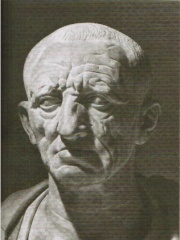
10. Cato the Elder (243 BC - 149 BC)
With an HPI of 79.82, Cato the Elder is the 10th most famous Italian Writer. His biography has been translated into 68 different languages.
Marcus Porcius Cato (, KAH-toe; 234–149 BC), also known as Cato the Censor (Latin: Censorius), the Elder and the Wise, was a Roman soldier, senator, and historian known for his conservatism and opposition to Hellenization. He was the first to write history in Latin with his Origines, a now fragmentary work on the history of Rome. His work De agri cultura, a treatise on agriculture, rituals, and recipes, is the oldest extant prose written in the Latin language. His epithet "Elder" distinguishes him from his great-grandson Senator Cato the Younger, who opposed Julius Caesar. He came from an ancient plebeian family who were noted for their military service. Like his forefathers, Cato was devoted to agriculture when not serving in the army. Having attracted the attention of Lucius Valerius Flaccus, he was brought to Rome. He was successively military tribune (214 BC), quaestor (204), aedile (199), praetor (198), consul (195) together with Flaccus, and censor (184). As praetor, he expelled usurers from Sardinia. As censor, he tried to save Rome's ancestral customs and combat Hellenistic influences.
People
Pantheon has 304 people classified as Italian writers born between 630 BC and 1985. Of these 304, 30 (9.87%) of them are still alive today. The most famous living Italian writers include Elena Ferrante, Fausto Cercignani, and Claudio Magris. The most famous deceased Italian writers include Dante Alighieri, Virgil, and Ovid. As of April 2024, 9 new Italian writers have been added to Pantheon including Donato Carrisi, Elisabetta Gnone, and Paolo Cognetti.
Living Italian Writers
Go to all RankingsElena Ferrante
1943 - Present
HPI: 74.21
Fausto Cercignani
1941 - Present
HPI: 73.47
Claudio Magris
1939 - Present
HPI: 65.36
Eugenio Barba
1936 - Present
HPI: 62.83
Alessandro Baricco
1958 - Present
HPI: 62.58
Dacia Maraini
1936 - Present
HPI: 62.45
Susanna Tamaro
1957 - Present
HPI: 59.40
Erri De Luca
1950 - Present
HPI: 59.19
Teresa de Lauretis
1938 - Present
HPI: 58.62
Valerio Massimo Manfredi
1942 - Present
HPI: 58.13
Elisabetta Dami
1958 - Present
HPI: 57.25
Roberto Saviano
1979 - Present
HPI: 57.17
Deceased Italian Writers
Go to all RankingsDante Alighieri
1265 - 1321
HPI: 92.13
Virgil
70 BC - 19 BC
HPI: 88.05
Ovid
43 BC - 17
HPI: 86.87
Petrarch
1304 - 1374
HPI: 86.60
Giovanni Boccaccio
1313 - 1375
HPI: 85.98
Horace
65 BC - 8 BC
HPI: 84.80
Umberto Eco
1932 - 2016
HPI: 83.13
Giacomo Casanova
1725 - 1798
HPI: 83.07
Giorgio Vasari
1511 - 1574
HPI: 82.06
Cato the Elder
243 BC - 149 BC
HPI: 79.82
Carlo Collodi
1826 - 1890
HPI: 79.68
Plautus
254 BC - 184 BC
HPI: 79.62
Newly Added Italian Writers (2025)
Go to all RankingsDonato Carrisi
1973 - Present
HPI: 52.02
Elisabetta Gnone
1965 - Present
HPI: 49.75
Paolo Cognetti
1978 - Present
HPI: 47.50
Michela Murgia
1972 - 2023
HPI: 47.09
Nicodemo Gentile
1969 - Present
HPI: 44.10
Melissa Panarello
1985 - Present
HPI: 40.10
Cristina Ali Farah
1973 - Present
HPI: 38.80
Gabriele Tinti
1979 - Present
HPI: 37.82
Maurizio Giuliano
1975 - Present
HPI: 36.39
Overlapping Lives
Which Writers were alive at the same time? This visualization shows the lifespans of the 25 most globally memorable Writers since 1700.


